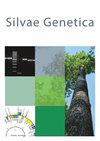日本赤松(Pinus densiflora Siebold et Zucc.)开放性传粉科对松材线虫抗性的木材特性遗传
IF 1
4区 农林科学
Q3 FORESTRY
引用次数: 0
摘要
松树萎蔫病是世界范围内发生最严重的树木病害之一。选育了具有松材线虫抗性的密松无性系。除了抗性,木材质量也是选育计划中的一个重要标准,因为它可以用作建筑木材。然而,关于抗病无性系后代木材质量的资料很少。对11个具有松材线虫抗性的开放传粉密植松材科进行了木材特性的重复性研究。在第3和第4年轮测量了干密度、管胞长度、管胞S2层微纤维角(MFA)、弹性模量(MOE)和断裂模量(MOR)。木材性能与茎粗、树高之间无显著相关。然而,烘干密度与MOE或MOR之间存在显著相关性,这表明烘干密度是选择具有较高弯曲性能的木材的良好指标。在测定的木材性能中,干燥密度的重复性最高(R=0.47),其次是MOR (R=0.33)、管生管长(R=0.21)和MFA (R=0.14)。MOE最低(R=0.01)。根据11个科的生长特征、木材特性和对松材枯萎病的抗性将其分为3个组。在此基础上,我们得出结论,对耐药密林木的木材性能,特别是木材密度和MOR进行遗传改良是可能的。本文章由计算机程序翻译,如有差异,请以英文原文为准。
Inheritance of the wood properties of the Japanese red pine (Pinus densiflora Siebold et Zucc.) from the open-pollinated families selected as resistance to the pine wood nematode
Abstract Pine wilt disease is one of the most serious tree diseases occurring worldwide. Clones of Pinus densiflora Siebold et Zucc with pine wood nematode resistance were selected. In addition to resistance, wood quality is also an important criterion in the breeding program of P. densiflora because of its use as construction lumber. However, little information is available on the wood qualities of the progenies of resistant clones. The repeatabilities of the wood properties were investigated for 11 open-pollinated families of P. densiflora selected for their pine wood nematode resistance. Oven-dry density, latewood tracheid length, the microfibril angle (MFA) of the S2 layer in latewood tracheids, modulus of elasticity (MOE), and modulus of rupture (MOR) were measured in the third or fourth annual ring from the pith. No significant correlations were found between the wood properties and the stem diameter or tree height. However, significant correlations were found between oven-dry density and MOE or MOR, which suggests that oven-dry density is a good indicator for selecting wood with higher bending properties. Among the measured wood properties, oven-dry density had the highest repeatability (R=0.47), followed by MOR (R=0.33), tracheid length (R=0.21), and MFA (R=0.14). MOE had the lowest value (R=0.01). The 11 families examined were classified into three groups according to their growth characteristics, wood properties, and resistance to pine wilt disease. On the basis of the results, we conclude that genetic improvement of wood properties especially for wood density and MOR is possible for the resistant P. densiflora.
求助全文
通过发布文献求助,成功后即可免费获取论文全文。
去求助
来源期刊

Silvae Genetica
农林科学-林学
CiteScore
2.20
自引率
10.00%
发文量
10
审稿时长
3 months
期刊介绍:
Silvae Genetica is an international peer reviewed journal with more than 65 year tradition and experience in all fields of theoretical and applied Forest Genetics and Tree breeding. It continues "Zeitschrift für Forstgenetik und Forstpflanzenzüchtung" (Journal of Forest Genetics and Forest Tree Breeding) founded by W. LANGNER in 1951.
 求助内容:
求助内容: 应助结果提醒方式:
应助结果提醒方式:


